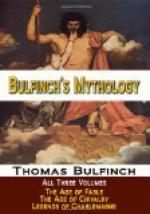Caradoc and Guimier are the hero and heroine of the ballad Of the “Boy and the Mantle,” which follows:
“The boy and the mantle
“In Carlisle dwelt King
Arthur,
A prince of passing
might,
And there maintained his Table
Round,
Beset with many
a knight.
“And there he kept his
Christmas,
With mirth and
princely cheer,
When lo! a strange and cunning
boy
Before him did
appear.
“A kirtle and a mantle
This boy had him
upon,
With brooches, rings, and
ouches,
Full daintily
bedone.
“He had a sash of silk
About his middle
meet;
And thus with seemly curtesie
He did King Arthur
greet:
“’God speed thee,
brave King Arthur.
Thus feasting
in thy bower,
And Guenever, thy goodly queen,
That fair and
peerless flower.
“’Ye gallant lords
and lordlings,
I wish you all
take heed,
Lest what ye deem a blooming
rose
Should prove a
cankered weed.’
“Then straightway from
his bosom
A little wand
he drew;
And with it eke a mantle,
Of wondrous shape
and hue.
“’Now have thou
here, King Arthur,
Have this here
of me,
And give unto thy comely queen,
All shapen as
you see.
“’No wife it shall
become,
That once hath
been to blame.’
Then every knight in Arthur’s
court
Sly glanced at
his dame.
“And first came Lady
Guenever,
The mantle she
must try.
This dame she was new-fangled,
[1]
And of a roving
eye.
“When she had taken
the mantle,
And all with it
was clad,
From top to toe it shivered
down,
As though with
shears beshred.
“One while it was too
long,
Another while
too short,
And wrinkled on her shoulders,
In most unseemly
sort.
“Now green, now red
it seemed,
Then all of sable
hue;
‘Beshrew me,’
quoth King Arthur,
‘I think
thou be’st not true!’
“Down she threw the
mantle,
No longer would
she stay;
But, storming like a fury,
To her chamber
flung away.
“She cursed the rascal
weaver,
That had the mantle
wrought;
And doubly cursed the froward
imp
Who thither had
it brought.




